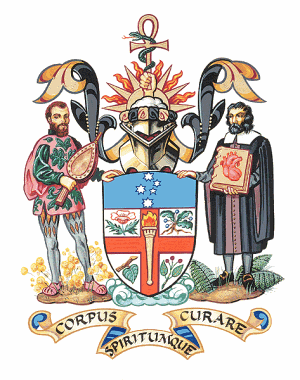College coat of arms
We were awarded letters patent for a coat of arms and crest in 1992. Letters patents are a published written order issued by a monarch granting an office, right, title or status to a person or corporation.

Our coat of arms consists of an illustration of Belgian-born anatomist and physician Andreas Vesalius and English physician William Harvey standing on either side of a shield. Vesalius is standing on Cootamundra wattle, which represents Australia. Harvey is standing on silver fern branches, representing New Zealand. The land they stand on is separated by water, signifying not only the separation of Australia and New Zealand but the separation of the “new world” from the “old world”.

Vesalius was the first to record the use of artificial ventilation to sustain life. He is depicted holding a bellows, which signifies his achievement, and is looking outwardly, as a gesture to the now widespread place of artificial ventilation in anaesthesia.

Harvey was the first to record the circulation of blood. He is holding a book displaying a heart, representing his achievement. Harvey is looking toward Vesalius in a gesture to Vesalius’s earlier work, which contributed to Harvey’s discovery.

The shield in the centre of the coat of arms holds a lot of symbolism. The top third consists of the Southern Cross on a blue background, indicating ANZCA’s position in the southern hemisphere. The layout of the stars references the Victorian state flag, the location of our college headquarters.
The St George Cross separates the lower portion of the shield into quarters. The St George Cross indicates professional links to the Royal College of Anaesthetists. The “torch of glory” sits over the axis of the cross and indicates ANZCA’s link to the Royal Australasian College of Surgeons whose motto, Fax mentis incendium gloriae, means “The torch of glory inflames (inspires) the mind”.
Each of the quadrants contains a representation of pharmacology fundamental to anaesthesia. The upper half displays botanicals representing the “old world”, while the lower half contains botanicals representing the “new world”.
In the upper left quadrant is an opium poppy flower (Papaver somniferum), signifying analgesia.
In the upper right quadrant is a mandrake plant (Mandragora officinarum), signifying sedation and anaesthesia.
The lower left quadrant holds curare vine (Chondrodendron tomentosum), signifying neuromuscular paralysis.
The lower right quadrant contains cocaine leaf and red fruit (Erythroxylum coca), signifying local anaesthesia.

Above the shield is the coat of arms featuring a helmet with a closed visor, indicating readiness for action. The type and position of the helmet has been drawn from the Royal College of Anaesthetists (RCA) and represents the close links between the RCA and ANZCA. The golden colour of the wreath and lambrequin is reflected in ANZCA’s academic regalia.

The rising sun above the helmet indicates ANZCA’s location in the east and links with the Royal Australasian College of Surgeons and the Royal Australasian College of Physicians, each of which also has a rising sun. The hand, rising from a cloud in front of the sun and grasping an ankh, symbolises a fellow, guided in the caring for a patient’s life.

The ankh has a snake wound around it. The ankh is an Egyptian symbol for life and references the roots of European medicine in Egypt, while the snake of Aesculapius symbolises a heritage link to Greek medicine.

At the base of the coat of arms is a scroll containing the motto, Corpus curare spiritumque, meaning “To care for the body and its breath of life”.
How we created the coat of arms
Read an account by Professor Barry Baker, one of the founding fellows of ANZCA who helped create our coat of arms.